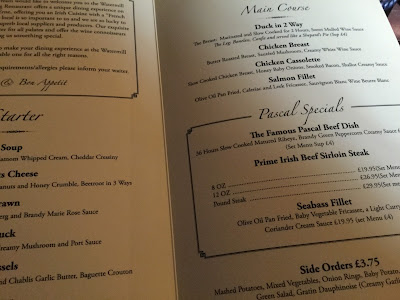 |
| Watermill Lodge |
It is always a true pleasure to visit County Fermanagh.
I was there for four days several years ago.
The main road from Belfast to Enniskillen is so good now that one can drive for a good part of the way at 70mph; though the Augher-Clogher-Fivemiletown section is at 30mph through the villages.
I stayed in Lisnaskea, the county's second town, I gather.
Belle Isle, the Duke of Abercorn's beautiful County Fermanagh estate and island, isn't far from Lisnaskea, so I motored over to have a look around and chatted with the staff in the visitor office.
I usually visit the Fermanagh National Trust properties so, having been invited to a private dinner at Crom estate on Wednesday evening, I revisited Crom the next day for a good walk to the old castle, the walled garden on Inisherk Island, and through sections of woodland.
I also visited Florence Court on Wednesday; and Castle Coole, a National Trust property and seat of the Earl of Belmore, many of whose paintings are on display in the mansion house.
Lord and Lady Belmore today live at the Garden House on the estate and their elder son John, Viscount Corry, keeps one of the wings at Castle Coole.
As a matter of interest I counted 28 chimneys on the main block and 14 on Lord Corry's wing.
A highlight of my trip to County Fermanagh was dinner at the Watermill Restaurant at Kilmore Lough, about two miles south-west of Lisnaskea.
Kilmore Lough is navigable from Upper Lough Erne and, indeed, there were lots of cruisers and boats at the quay.
Watermill Lodge is one of the most charming places, with a thatched roof, little ponds, herb gardens, streams, rockeries and more.
Pascal Brissaud's attention to detail is remarkable.
Even the lavatories have curving mosaic tiles and stone spouts, skin to little streams, from which water flows into the hand basins.
 |
| Large bellows table |
The Lodge is filled with character; the staff, smartly turned out, courteous, charming, diligent.
I sat at a table near the bar.
I perused the menu at length and chose prawn cocktail as a starter; not a common prawn cocktail, though, this one was served in a shell with juicy prawns.
As you'd expect, fresh breads were presented in a basked with hand-carved pats of butter.
The wine menu, by the way, has one of the finest selections in Northern Ireland, including several costing over £2,200 a bottle.
There is, should one require it, a helipad in the grounds (!).
For my main course I had the duck, served with creamed potato, sauce and a garnish (putting it simply).
I ordered a dish of mixed vegetables as well.
My pudding was a Pascal Special: dainty, little profiteroles.
I do not pretend to any kind of restaurant critic, though I thoroughly enjoyed my meal and of course the extraordinary location and ambiance of this restaurant and guest-house.
I hope to base myself here the next time.
















